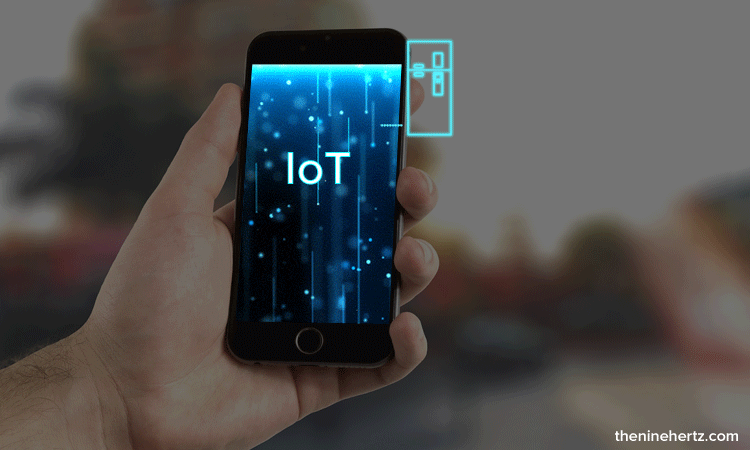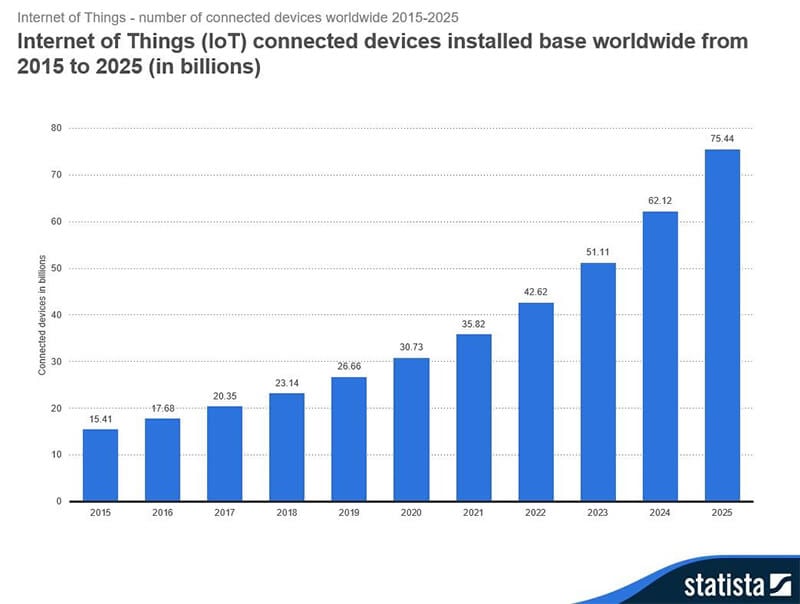
Imagine having a fridge so smart that it can order food for you when you run out of things. A refrigerator that can tell you what to make based on ingredients that you have. Or a fridge that lets you know that you forgot to shut the door. Remotely. Through an app on your mobile device!
Incredulous, isn’t it? But. That’s the beauty of IoT or Internet of Things.
So, what is IoT?
IoT is a network of devices. It is analogous to the World Wide Web which is essentially a network of computers. It lets devices exchange information and connect with each other.
Where can IoT be used?
Everywhere. From healthcare to the household, IoT has several uses. It can be used by an individual, a team or an organization to automate things and make lives more comfortable.
IoT is destined to become massive in the next few years and here are 8 stats to prove that:
- Exponential Growth in various Industries: IoT finds use in several industries. We will see an incredible increase in the International Internet of Things (IoT) industry from $2.99T in 2014 to $8.9T in 2020 from, making Compound Annual Growth Rate (CAGR) 19.92%. It is used in Healthcare in the form of remote monitoring, smart sensors, and medical device integration.
Life sciences and IoT Application in Healthcare are expected to grow to $1.335T in 2020, amounting to 17% CAGR. Industrial manufacturing uses the Internet of Things solutions to monitor manufacturing devices and processes. That cuts down on manufacturing costs. IoT usage in Industrial manufacturing is projected to grow from 2014’s $472B to $890B in 2020.
- Rising Valuation: The IoT market is set to increase from its valuation of $157B in 2016 to estimated $457B by 2020, accomplishing the CAGR of 28.5%. The lion’s share of the industry’s market is going to be dominated by three sub-domains; Smart Cities – 26%, Industrial – 24%, and Connected Health – 20%. A rise in Smart Homes by 14%, Connected Cars by 7%, Smart Utilities by 4%, and Wearables by 3% will follow suit.
- Rise in B2B IoT: Bain forecasts that the B2B IoT market will rake in $300 Billion yearly by 2020. That consists of $85B in the industrial sector. Most of the competition in IoT will be seen in industrial and enterprise segments. Bain predicts that consumer apps will raise $150B by the year 2020, with the B2B apps being estimated at over $300B.
- Investment: PwC estimates that between 2015 and 2020, $6T is expected to be spent on the Internet Of Things (IoT) solution industry. The number of IoT investments made by the businesses will increase from its $215B valuation of 2015 to its $832B number in 2020, while the consumer IoT spending will increase from $72B to $236B.
- B2B Expenditure: By 2020, the B2B expenditure on IoT technologies, solutions, and apps will go up to €250B ($296.8B). $23.7B will be spent on IoT Analytics expenditure by the year 2020. The revenue from every layer of IoT technology stack will have managed to make at least 20% CAGR in between 2015 and 2020.
- IoT solutions: The two domains that primarily have been using IoT is refining the customer experiences (70%) and enabling safety (56%). The three most common uses of the data collected are attaining cost efficiencies, bettering the organization abilities, and gaining the supply chain visibility (53%).
It is expected that Internet of Things solutions will increase the revenue and give way to new markets around the globe. This prediction has led to a rise in Enterprise IoT Mobile Apps, worldwide.
- Number of Devices: The mounting base of the Internet of Things devices is also expected to grow to 31B globally by 2020. And by 2025 the number will surpass 75.4B devices.

- Economic contribution: McKinsey Global, a premium research institute, has theorized by the year 2025, that IoT will make a yearly economic contribution between the ranges of $3.9T to $11.1T. They arrived at this prediction by taking into account a lot of scenarios such as use cases and diverse settings including cities, factories, retail environments, and healthcare.
What is the future of IoT?
More sensors
Embedded sensors are used to collect data from around the world. The IoT sensor market alone is expected to be worth a staggering $27 billion by 2022. That means we will see a whole lot of sensors in the future.
Data privacy will become a priority
When it comes to IoT, one of the main concerns consumers and developers have had is concerns about privacy. The Equifax fiasco and Cambridge-Analytica quickly come to mind when talking about the data breach. IoT products are going to be strictly regulated, and privacy will be the primary concern in the future.
Machine learning
Machine Learning is going to become an integral part of IoT devices. Big companies like Microsoft, IBM, and Google, are investing in AI and machine learning. That is the only way we can keep moving forward.
Tightened Security and Higher physical standards
Hacks and data breaches have proved that the security of IoT devices needs to be kicked up several notches. Another change we will see is in the physical standards. Devices will be valued based on their level of security and endurance in the future rather than how cheap they are to produce.
Changing the manufacturing process will change consumer patterns and marketing trends. Battery life will become more of a concern. The standards of production will have a higher benchmark.
Top mobile app developers who develop IoT apps will enforce their own standards to prevent outside regulation.
The only thing that is not likely to change is that IoT will only grow to become a more evolved technology. It will be used in every industry, and people will embrace and accept it as a part of their life. The newer IoT devices are going to be different, better and one step closer to solving all our problems.




That’s a great read and certainly seems to point to the way we’re headed. One thing I think should be added is the pressure this is going to put on bandwidth. Already, in our experience, IoT solutions and larger rollouts are causing headaches with regard to connectivity, and IoT projects are having to pick and choose what data they want transmitted, and when. This will be even more problematic when the majority of information on a bandwidth scale is video and audio data. (We saw consumer bandwidth use explode when the smart phone came out with its video capabilities). Having just published an article about bandwidth use in the next decade, (using Neilsen’s Law as a starting point), I think the IoT will have to use a number of strategies to be successful, including: bandwidth on demand to manage non-critical data transfers, prioritising what data to transfer, computing at the Edge, and, of course, 5G.
Thanks for your valuable thoughts. Your point on the Bandwidth management is something which surely many of us are concerned about too.
Comments are closed.